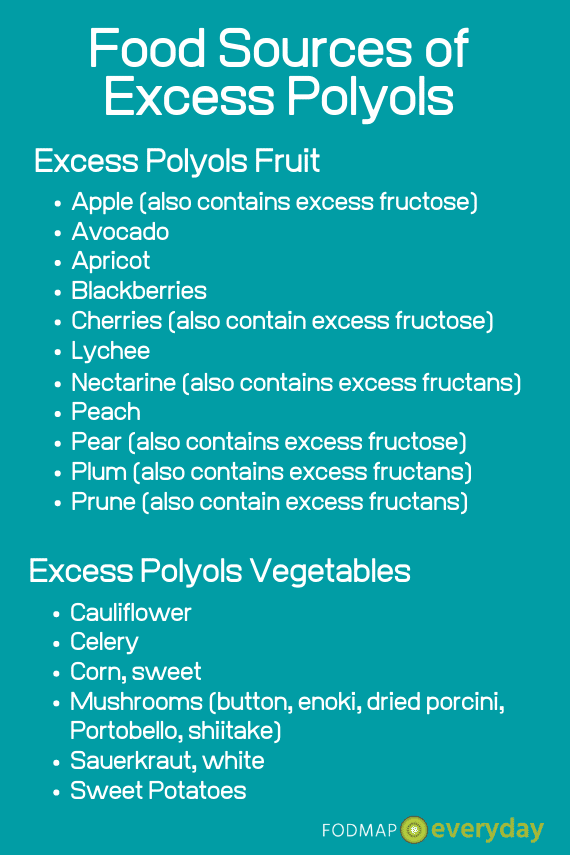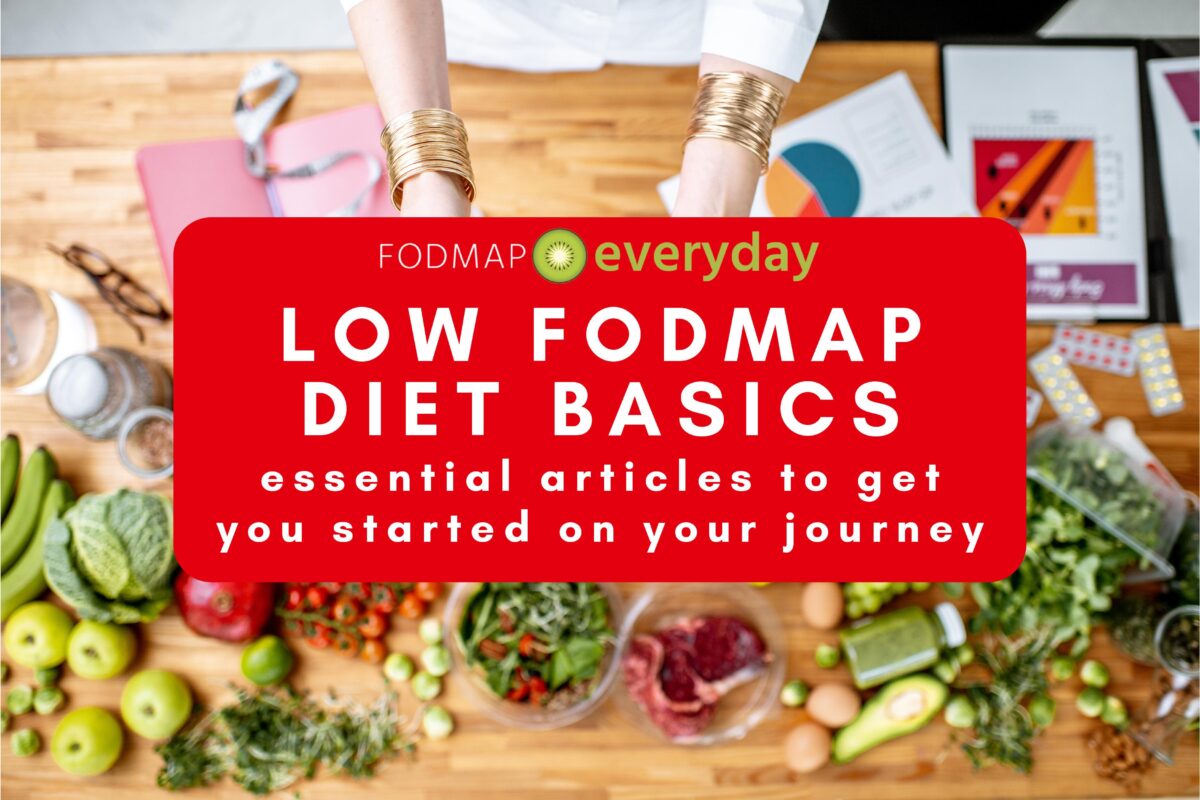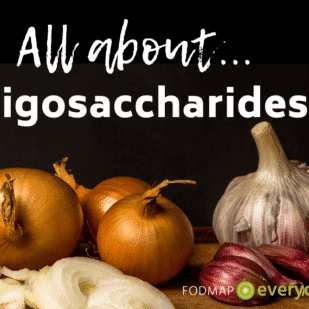If you are following the low FODMAP diet, have irritable bowel syndrome (IBS) or are curious about what polyols are, this article has information you need.
Let’s Talk About the “P” in FODMAP
The acronym FODMAP stands for Fermentable Oligosaccharides, Disaccharides, Monosaccharides and Polyols.
The “P” in FODMAP stands for polyols, but you may know them by another name – “sugar alcohols” – or perhaps by the sweetener names erythritol, isomalt, lactitol, maltitol, mannitol, sorbitol, and xylitol, which are low-calorie sweeteners.

Polyols are generally considered beneficial for managing blood glucose levels because they are digested and absorbed more slowly than regular sugar, leading to a lower glycemic impact, but that soes not mean that they are suitable for those with IBS or following the low FODMAP diet.
The Chemistry of the “P” in FODMAP
Polyols are small-chain carbohydrates that occur naturally in certain fruits and vegetables or as additives in packaged foods. The two that have been extensively evaluated by the Monash University researchers who developed the low FODMAP diet are sorbitol and mannitol (you can see them on the Monash smartphone app).

What Causes Polyol Malabsorption?
Poyols are absorbed through pores in the small intestinal epithelium. This occurs slowly in all people, but the rate is influenced by factors that include polyol dose and type, gut transit time, size of the small intestinal epithelial pores, and the presence of intestinal disorders that reduce epithelial pore size, such as celiac disease.
Clearly, some people are predisposed to malabsorb these sugars due to factors that are not under their control, but just about everyone will experience digestive symptoms if they consume more than 10 to 20 grams of polyols at one time.
That’s why packaged foods that contain sorbitol and mannitol must include a warning that states, “Excess consumption may have a laxative effect.”

Polyols & Gut Symptoms
Similar to fructose, polyols attract water as they move through the small intestine by a process called osmosis. This occurs whether polyols are absorbed or not, but it can lead to pain and motility problems (typically, diarrhea) for people who are more sensitive to the pressure this fluid exerts on the intestinal walls.
Polyols that are not absorbed in the small intestine enter the large intestine where they are fermented by gut bacteria. The gas produced as a by-product of this bacterial fermentation distends the bowel, causing additional pain, bloating, and altered bowel habits in susceptible individuals.
Certain polyols (notably erythritol) are better tolerated than others because they are more efficiently absorbed in the small intestine. This reduces both the osmotic effect they exert in the small intestine and the amount of intact polyol molecules available for fermentation in the large intestine.
Testing for Polyol Malabsorption
Breath tests for sorbitol and mannitol malabsorption are available, but they are infrequently ordered. That’s actually a good thing since these tests are not particularly helpful as diagnostic tools.
For one thing, they’re not reproducible, i.e., you can get a positive result one day and a negative result soon after. Another downside to these tests is that the polyol dose used is often much larger than a person would typically consume in one sitting. More importantly, though, poyols can cause symptoms whether or not they are absorbed.
A more reliable way to find out if polyols are problematic for you is to initiate a polyol-restricted diet followed by a “test-to-tolerance” trial (like the Elimination and Challenge Phases of the low FODMAP diet).
An invaluable resource for those of you who choose this route is the Monash University FODMAP diet app, which lists the sorbitol and mannitol content of hundreds of foods.
Information about other polyols is not available on the app, but if you have trouble with sorbitol and mannitol you’ll probably need to limit most other poyols as well.
A quick way to identify additional polyols in the ingredients lists of packaged foods is to look for an “ol” ending, e.g., maltitol, xylitol, and lactitol; one polyol that bucks this trend is isomalt.
Food Sources of Polyols
Polyols are primarily found in stone fruits and as additives in sugar-free chewing gum, sugar-free candies, and other low-cal or carb-free foods. They are also found in a number of fruits and vegetables such as:
- Apples
- Apricots
- Avocado
- Apricots
- Blackberries
- Cauliflower
- Celery
- Cherries
- Corn
- Lychee
- Mushrooms
- Nectarines
- Peaches
- Pears
- Plums and Prunes
- Sauerkraut
- Sweet potatoes
- Wakame seaweed

Frequently Asked Questions
We are concerned with FODMAPs, and polyols are a FODMAP and therefore can trigger IBS symptoms.
While they have a sweet taste and are carbohydrates, polyols are not sugars in the traditional sense.
It depends on your medical picture, including your digestion. For someone who is diabetic, they are sometimes recommended as they have a lower impact on blood glucose levels than regular sugar. For those with IBS they can wreak havoc.
They have a lower impact on blood sugar levels than sugar.
Polyols are a type of carbohydrate, but they are often subtracted from total carbohydrates when calculating “net carbs” because they are not fully absorbed by the body.
It depends on your medical and digestive needs. For those following the low FODMAP diet, regular white table sugar contains no FODMAPs at all and is a great choice.
It depends on your medical and digestive needs.
Toothpaste, mouthwash, some “diet” ice cream, breathe mints, even throat lozenges. These sugar-free foods are popular as they typically have fewer calories, but dietitian nutritionists (RDNs) caution that they can cause digestive upset and affect the gut microbiome negatively.
Bottom Line
Polyols are notorious for causing gastrointestinal symptoms if the amount consumed exceeds your absorptive capacity.
Packaged foods with added polyols are often of low nutritional value and ought to be avoided, but whole foods that contain these sugars should be kept in the diet if possible.
You can discover your personal comfort level for such foods using a systematic method like the three phases of the low FODMAP diet.
Be sure to read all of the other articles in this series!









You forgot SWEET POTATOES — HIGH in mannitol.
Yes they are! This was not meant to be an exhaustive list. For that we always turn to our trusty Monash app. Hopefully you have found an amount of sweet potatoes that work for you.
Thanks to y’all
This helped in my assignment.
Hi, FODMAP’s do not bother me, but I know people who are bothered. This article says, “Polyols that are not absorbed in the small intestine enter the large intestine where they are fermented by gut bacteria.” Could the right kind of and amount of Pre- or Probiotics help IBS? I suppose scientists are investigating these issues right now. Marv Hanner
Hi Marv, prebiotics and probiotics can help overall gut health and can be used to great effect, but Monash researchers (the developers of the diet) and RDs do not recommend their use during Elimination or the Challenge Phase as their inclusion can cloud the results you are looking for from eliminating or introducing FODMAPs. Once you know what your individual triggers are post Challenge Phase, then judicious use of supplements can take you even further. This article might be of interest for you on probiotics and we also have one on enzyme supplementation.
Will soaking onions in water before use in cooking and discarding the water dramatically reduce the FODMAP profile?
You are thinking along the right lines. Monash has lab tested vinegar pickled onions and they have a low FODMAP serving size, so, in theory, the answer to your question is yes. But what the FODMAP reduction would be is not known without lab testing. Something to try when you are stable and in your Challenge stage.
I have ibsd, and am a sepsis shock survivor, have many feet of small intestines removed. Try to follow Monash app. Need all the help available, seems a an sensitive to all fodmaps
Hi Diana, I am so sorry to hear about your situation but thank you for sharing. The good news is that you can get help. Even more then gastroenterologist, it is the Registered Dietitians who can make all the difference in the practical everyday needs and approaches that one needs to adopt to get better. And, the good news is that there are dietitians who specialize in IBD and IBS. I suggest you reach out to one of our Success Team RDs, Colleen Webb, and have a chat. You can read about her HERE.
I have a question about stacking polyols. The Monash app used to lump all polyols together. Now it gives mannitol and sorbitol as separate categories. Does that mean that I don’t need to worry about stacking when eating low portions of one item containing mannitol and another containing sorbitol at the same meal?
Also, I am particularly interested in xylitol as I have a prescription medicine which contains it (2 large chewable tablets a day), and my favourite mints (spearmint Smints) are 88% xylitol. I haven’t tested polyols yet but when I do I’m not sure how the results for sorbitol and mannitol will relate to xylitol.
Hi Jenny, you are right that mannitol and sorbitol are now individual listings in the app and the best case scenario is that you have challenged yourself in both of these polyols to understand your tolerance with each. If you have not, then I would look at polyols as one big thing. If you have, yes, you can consider mannitol and sorbitol separate when you’re looking at stacking. Of course, what the app says and what lab tests say can still be different from what your body reports back to you.
Xylitol is unfortunately found in a lot of things including medications. If you’ve been taking the medications with no ill effects then most RDs would suggest just proceeding as you have been. If you absolutely love something that contain xylitol, like your mints that you mention, then why not use the mints as a challenge and see how you do. Then you would know for sure whether the mints work for you or not. We also have an article on low FODMAP mints
Erica Ilton RD also wanted to point out that the most tolerated polyol tends to be erythritol. Perhaps choosing a mint sweetened with erythritol would allow you to leave xylitol for the medication you have to take?
Thank you for such a comprehensive response! I have been planning to test xylitol early in the maintenance phase but I’m only just starting reintroductions, so I need to follow the Monash for those first. I stopped the Smints when I first started the diet and I substituted that medication with a equivalent OTC one when I realised it contained xylitol. Fortunately there is one which doesn’t contain any FODMAPs.
I was mainly concerned about the stacking of polyols, which confused me. I’ve been treating mannitol and sorbitol as separate categories for stacking, but now I’ll treat all the polyols as one category until I’ve done the two Monash challenges (and xylitol).
Thanks again! I’ve found this site such a help already.
Glad we could help, Jenny. Basically, if you are willing to take time with your Challenge Phase – and break things down into more, individual tests – you will come out with more info on how your body reacts, which is what is important!